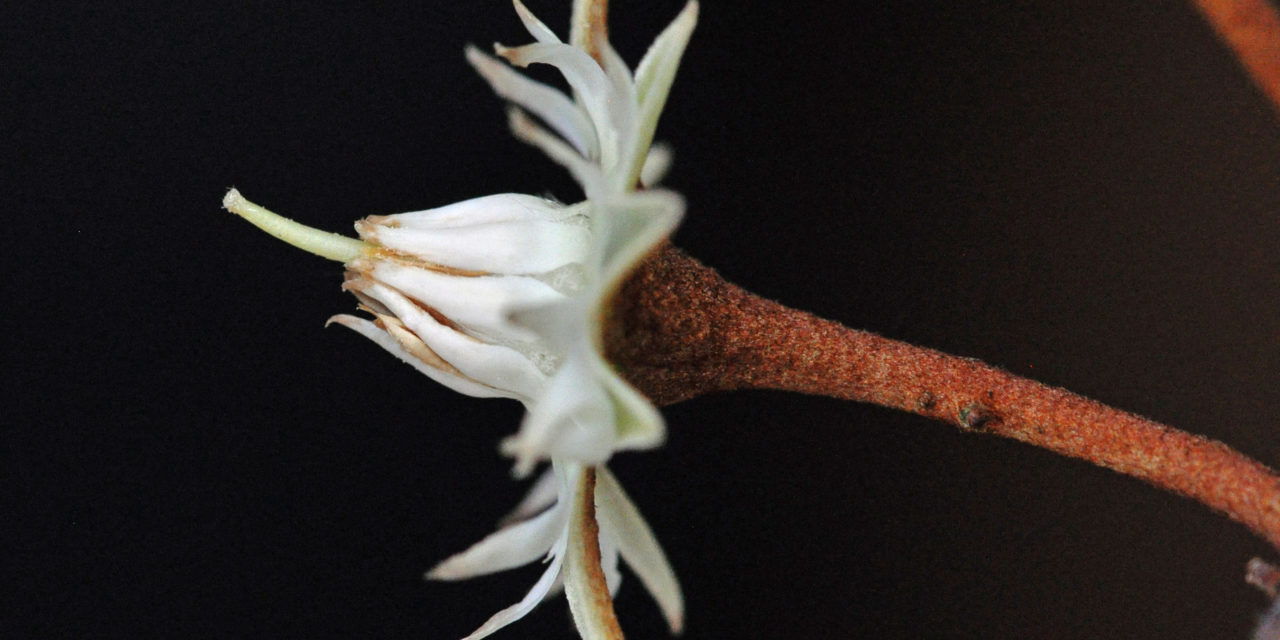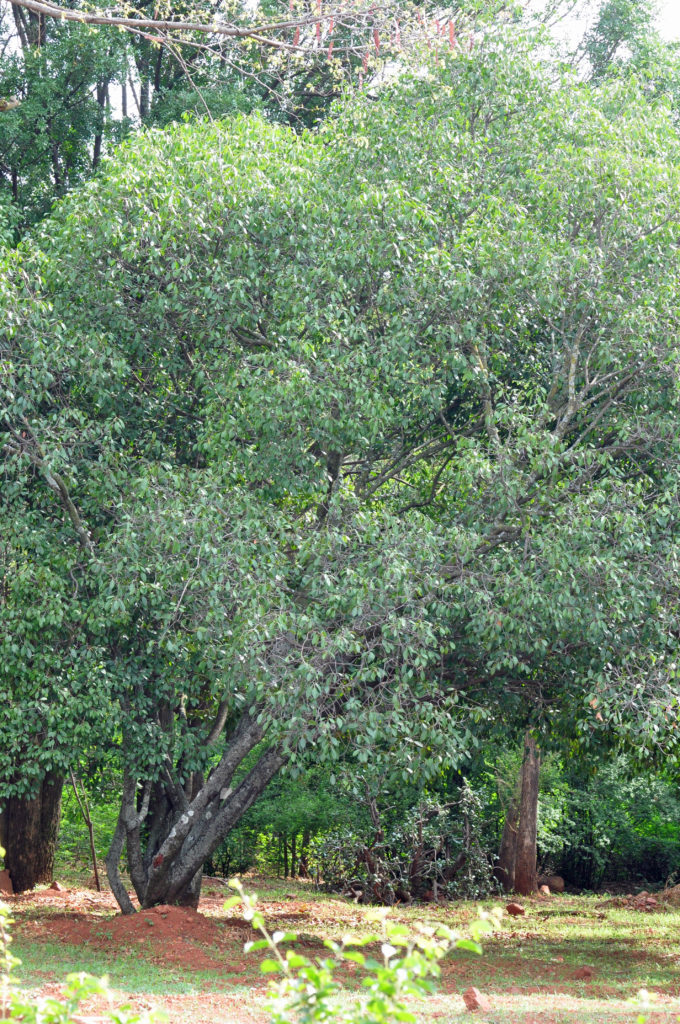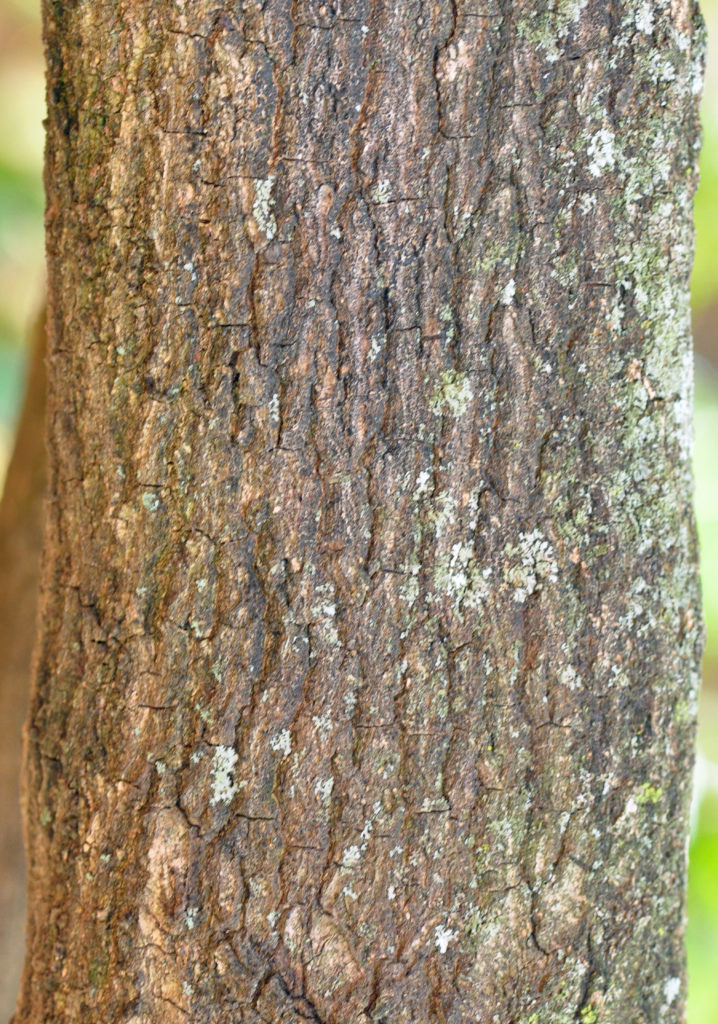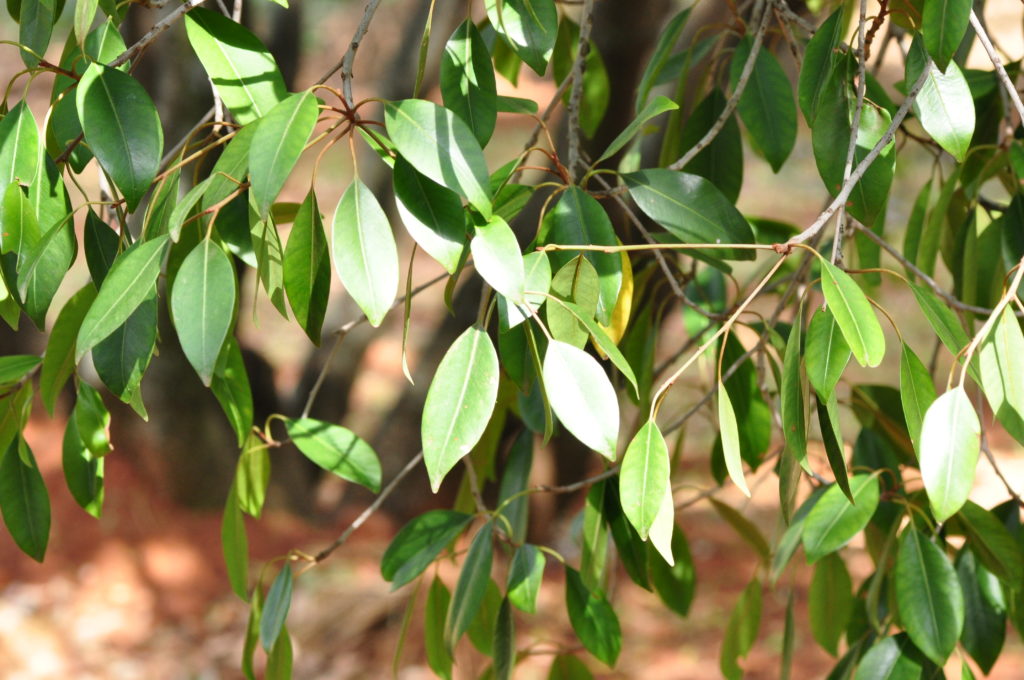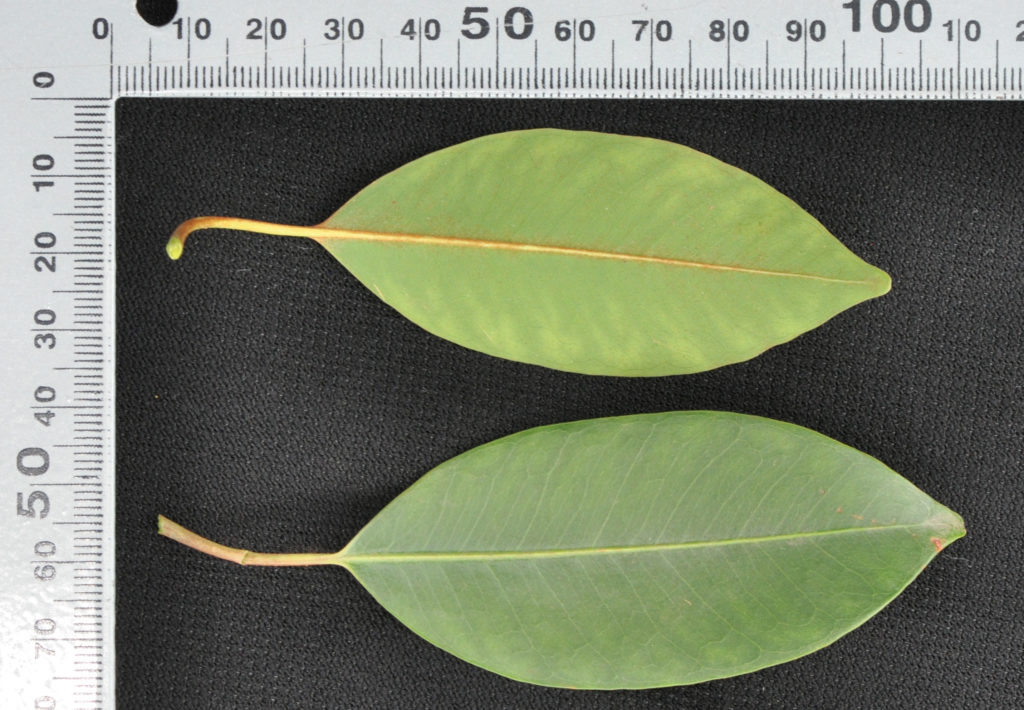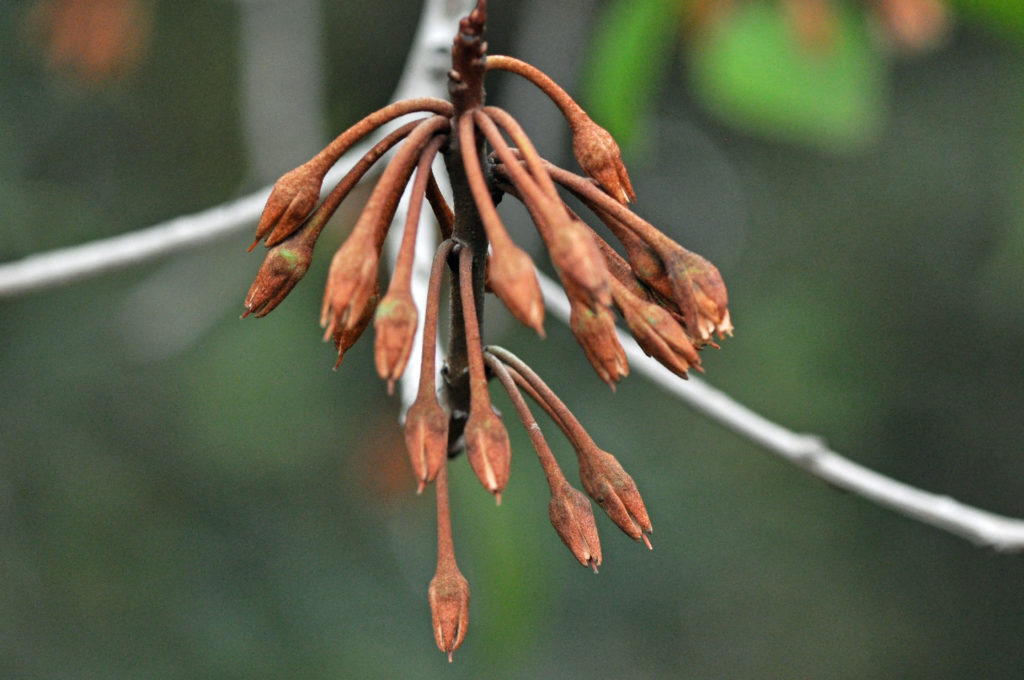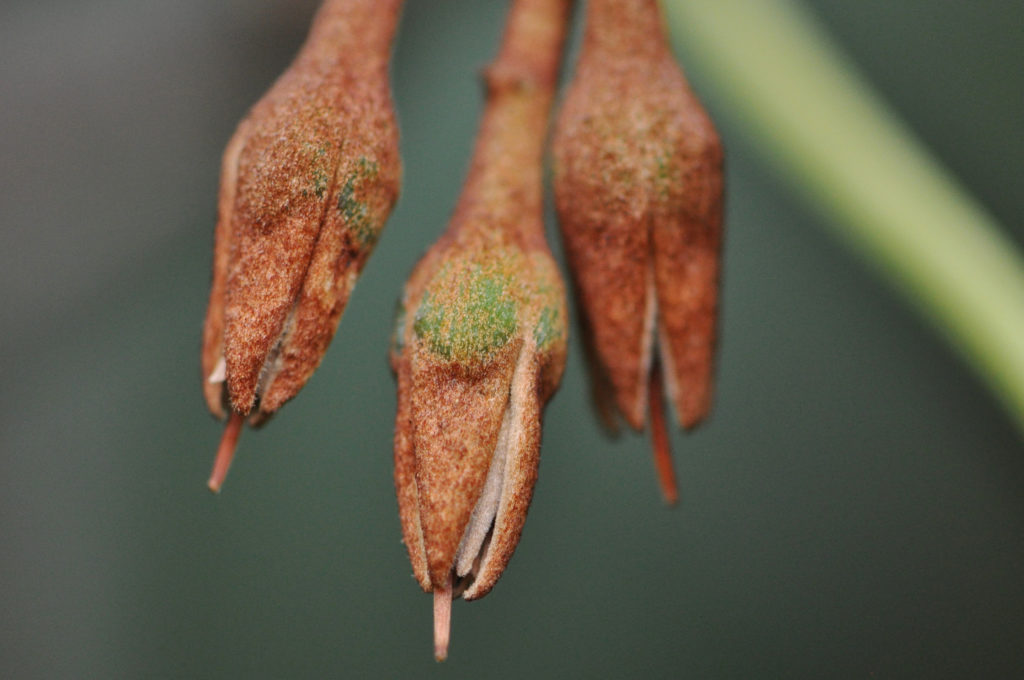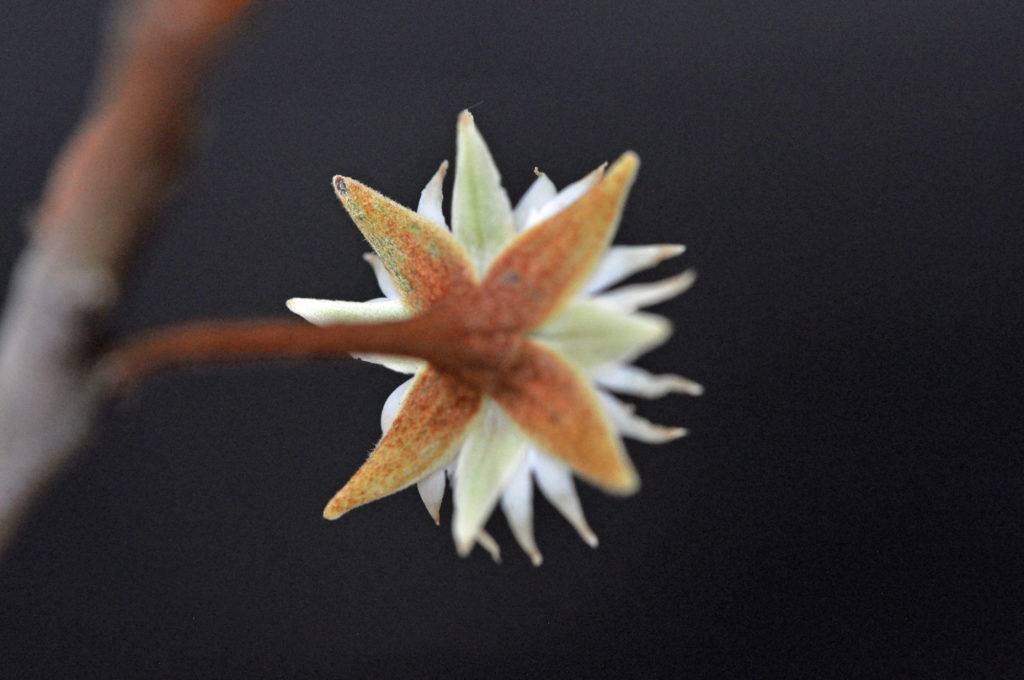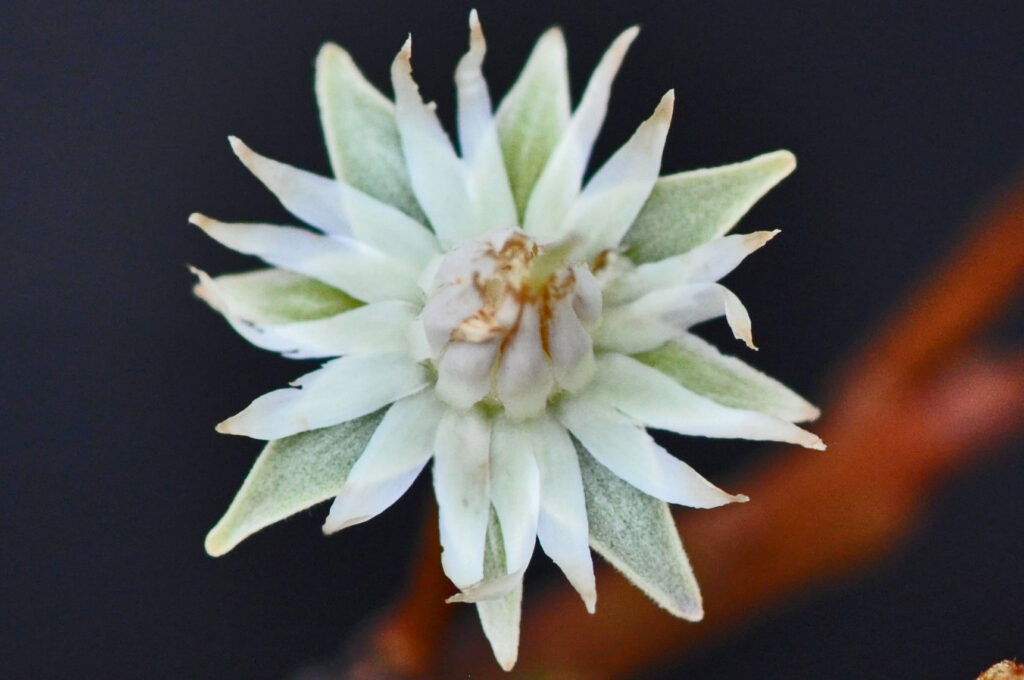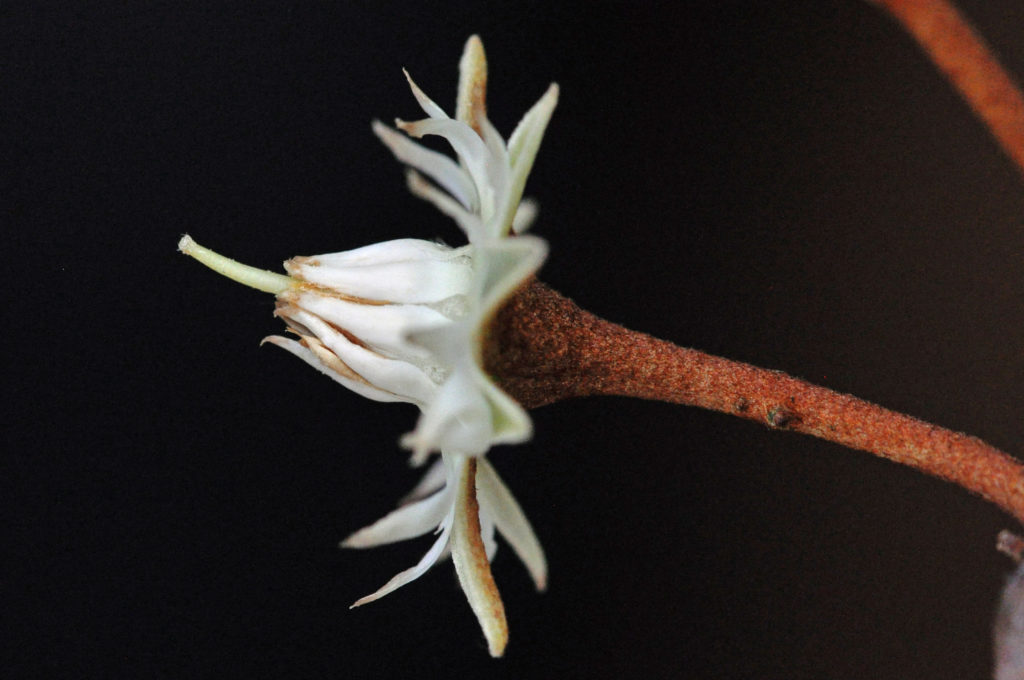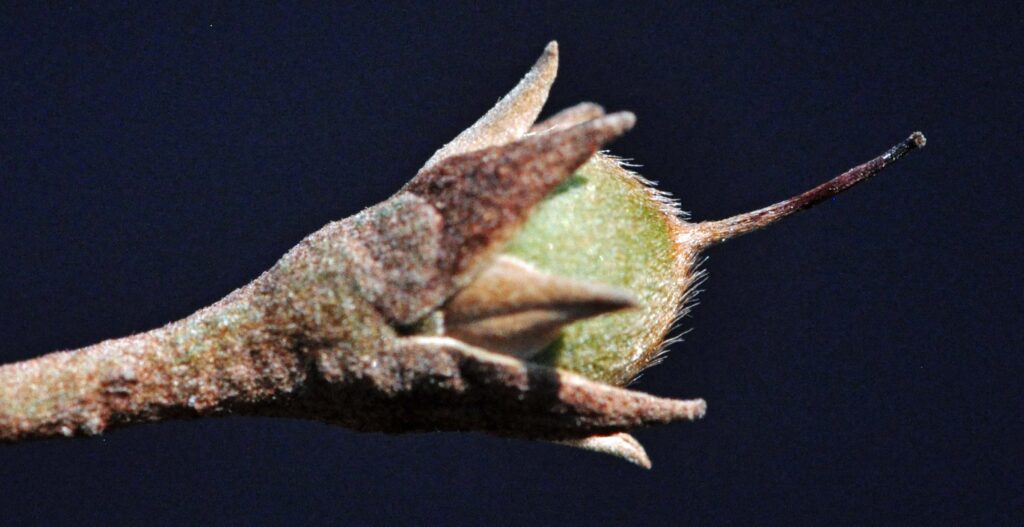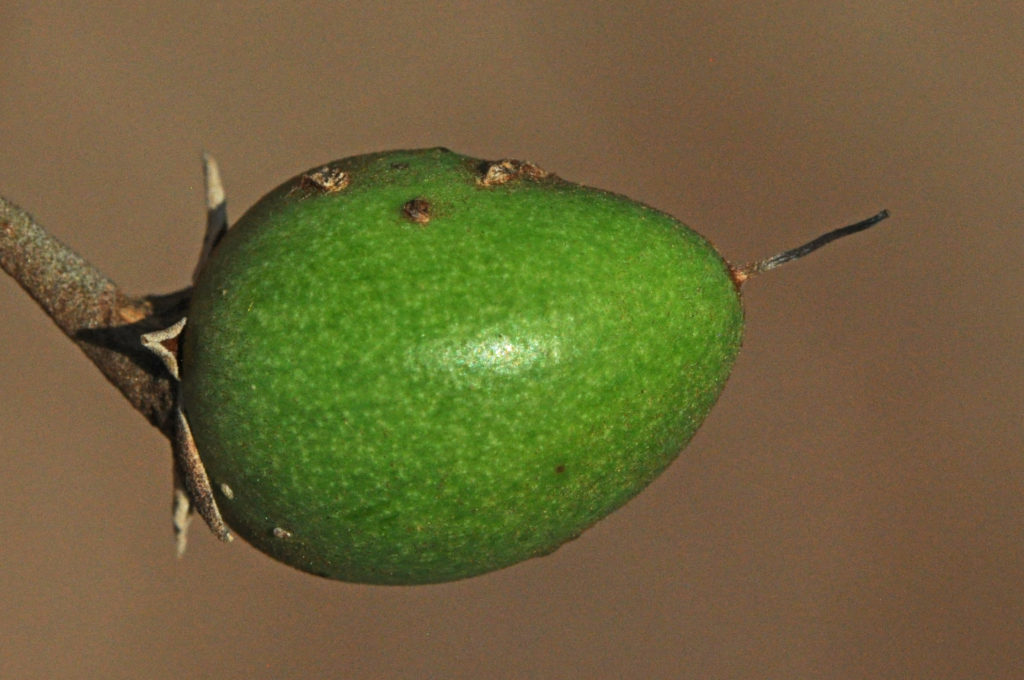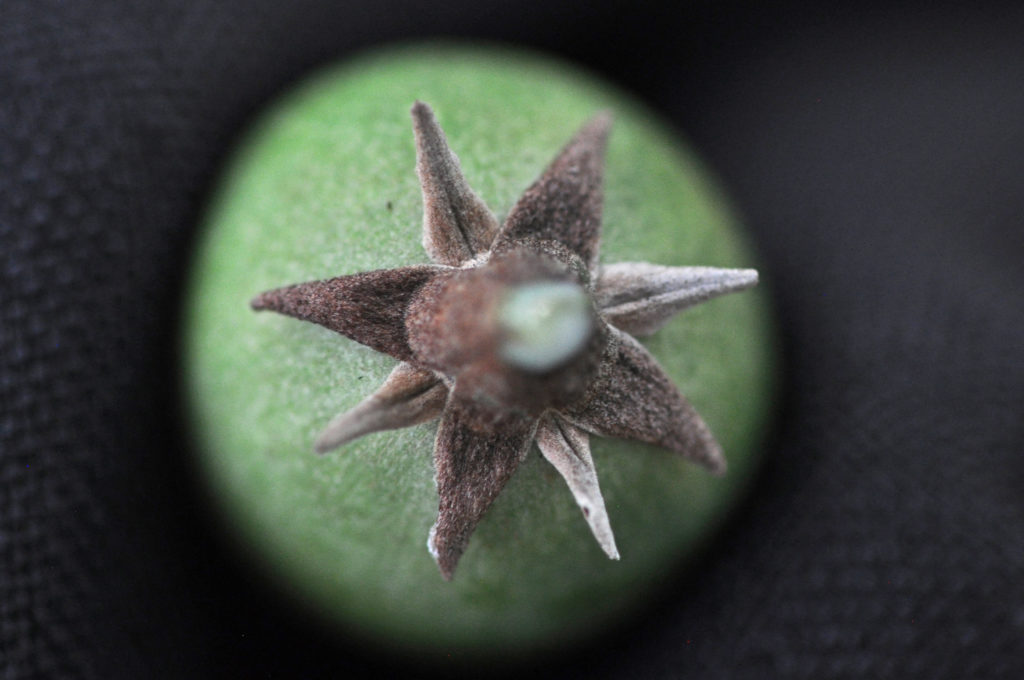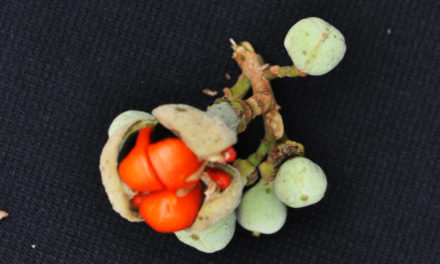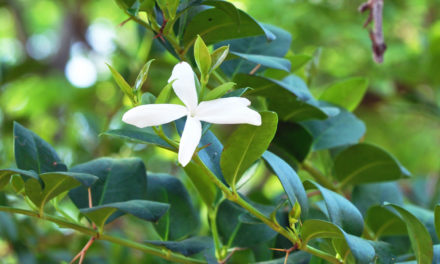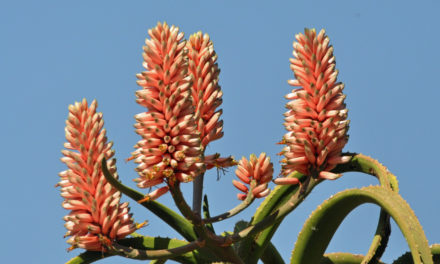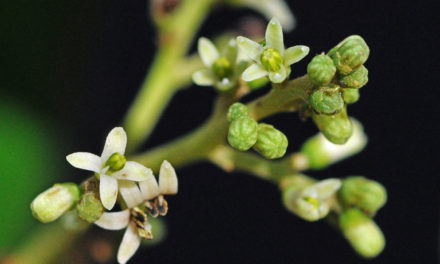General Info – summary
This medium to large sized southern African endemic Tree develops vertically fissured dark brown bark and may reach 19m high. Glossy stipulate Leaves are simple and narrowed towards the apex. Midrib protrudes on both sides. Whitish, bisexual, actinomorphic Flowers are 4-merous. Staminodes, 8 stamens and an 8 locular superior ovary with 1 protruding style are present. Fruit: orange berry with 1 shiny seed.
Description
Mimusops obovata
Previous Names: Imbricaria obovata, Mimusops oleifolia, Mimusops rudatisii, Mimusops woodii.
SA Tree No. 584.
Common names: (Afr) Bosmelkhout, Bosroooimelkhout, Moepel, Roooimelkhout. (Eng) Bush Red-milkwood, Red milkwood. (isiXhosa) Amasethole, Umntunzi, Umtunzi-wehlathi. (isiZulu) Amasethole, Amasethole-ehlathi,. (Northern Sotho) Mmupudu. (siSwati) Umphushane. (Tshivenda) Mububulu.
Family: Sapotaceae. (Stamvrug, latex-yielding family). This family is pantropical (distributed throughout the tropics) and includes 35-75 genera and approximately 800 species. Local genera with trees on this website include Englerophytum, Inhambanella, Mimusops, Sideroxylon and Vitellariopsis. Branches exude latex. Leaves are simple, entire and there are closely parallel secondary veins. Stipules are absent. Flowers are bisexual, usually actinomorphic (regular). There are persistent Sepals and fused Petals. The Stamens equal the number of petals. Staminodes may be present outside the fertile stamens. The superior Ovary has locules containing a single ovule. One Style and 1 Stigma are present. Fruit is a berry. Seeds have a thick brown shiny testa (seed coat) with a distinct pale scar. Seeds dispersed by birds, bats and mammals. There are 7 genera and 14 species in southern Africa.
Name derivation: Mimusops (resembling an ape face – unusual!). obovata refers to the simple obovate leaves. There are 4 species of the genus Mimusops in southern Africa. The other 3 are M. cafra, M. obtusifolia and M. zeyheri. Only M. obtusifolia does not develop into a tree.
Conservation: National Status: L C. (Least Concern). Assessed: 2018 (L. von Staden).
Tree
This Tree may reach 19m high but is usually up to 16m (photo 331). The reasonably straight Stem (main axis of the plant, the leaf and flower-bearing axis as distinguished from the root-bearing axis) is up to 0,5m wide. Fine hairs are present on young reddish branches. Milky sap is present. The initially smooth Bark is hairy and has usually has visible Lenticels (raised corky elongated areas on the plant that allows the uncontrolled interchange of gases with the environment (photo 499). It ages, becoming dark brown and vertically fissured (photo 329).
- 331. 2016/11/08. Pretoria NBG. Photo: David Becking.
- 329. 2016/11/08. Pretoria NBG. Photo: David Becking.
- 499. 2017/08/15. Pretoria NBG. Photo: David Becking.
Leaves
This usually evergreen tree has spirally arranged Leaves that are simple (have a single blade which may have incisions that are not deep enough to divide the blade into leaflets). The leaves are not conspicuously crowded at the ends of branches and tend to hang down (photo 332). Each leaf is up to 7 x 4cm (photo 335). N.B. Leaf length excludes the petiole (leaf stalk). Leaves are ovate, lanceolate, elliptic or obovate (the reverse of ovate, the terminal half is broader than the basal). Blade: Only leaves growing in direct sunlight are thinly leathery and only young leaves are pale green and have rusty coloured hairs. Glossy smooth leaves shine in the sun (photo 332). They are smooth above, and below they are slightly lighter and dull. Occasionally flower-like galls are visible. The Veins are not neatly parallel or obvious and only the Midrib protrudes on both sides (photo 335). The Apex is bluntly pointed, tapering or rounded. The Base tapers. Margins are entire (with a continuous margin, not in any way indented) and may be slightly rolled under. The Petiole (leaf stalk) is 2cm+ long (photo 335). Stipules (basal appendages of the petiole) are present.
- 332. 2016/11/08. Pretoria NBG . Photo: David Becking.
- 335. 2016/11/08. Pretoria NBG. Photo: David Becking.
Flowers
Trees in full sun tend to flower more profusely. Up to 3 fragrant, whitish-yellow Flowers develop in leaf axils. The sweetly scented flower parts are in 4’s. Each small flower is about 1cm wide, bisexual and actinomorphic (Regular, symmetrical. Flowers are vertically divisible into similar halves by more than 1 plane passing through the axis). The down hanging flowers (photo 631) are vertically divisible into similar halves by more than 1 plane passing through the axis). The hairy, Pedicels (stalks of individual flowers – occur singly or cluster in leaf axils). Each flower is up to 3cm long (photo 637). The Calyx has Sepals that are basally connate (united or joined). They are divided almost to the base. There are 8 lobes in 2 whorls of 4 each. The external of the outer whorl has reddish hairs (photo 633 and 638). The inner whorl only becomes visible once the flower has opened. Photo 634 shows that all 8 inner viewed lobes are light green. The Corolla has 8 white to cream lobes, and each lobe has 2 dorsal appendages. The Petals are in an inner role of 8 and the appendages in an outer row of 16. Lobes are gamopetalous (united joined petals – at least at the base) and imbricated (having regularly arranged, overlapping edges, as roof tiles). The 8 free Stamens are epipetalous (born on or arising from the petals). They are in 2-3 whorls but usually only the inner whorl is fertile. Each lanceolate Anther ends in a short, sharp, flexible point and is supported by a shorter filament. The Theca (pollen sacs) have longitudinal slits through which the pollen is shed. There are usually 8 hairy Staminodes (sterile stamens) present outside the fertile stamens. There is a single Pistil (a unit of the Gynoecium, the female element of the flower, composed of the Ovary, Style and Stigma). Here the 8 locular Ovary is superior (one that is free from the calyx or perianth) and has 1 ovule per locule. A single, slender Style is present which protrudes beyond opening bud (photo 633) and the flower as a whole (photo 637). (Aug-Dec).
- 631. 2018/01/30. Pretoria NBG. Photo: David Becking.
- 633. 2018/01/30. Pretoria NBG. Photo: David Becking.
- 638. 2018/01/30. Pretoria NBG. Photo: David Becking.
- 634. 2018/01/30. Pretoria NBG. Photo: David Becking.
- 637. 2018/01/30. Pretoria NBG. Photo: David Becking.
Fruit
The ripe, bright orange to red Fruit is a fleshy Berry (pulpy, indehiscent fruit like a grape or tomato). It is hairy when young (photo 152). The fruit is up to 3,5 x 2,5cm. It narrows towards the apex and resembles a miniature avocado (photo 684). A persistent Style (photos 152 & 684) and a backwards curling Calyx (photo 688) are present. The orange, mealy pulp of the berry is edible. It usually contains a single black or brown, shiny, keeled Seed. The seeds are up to 2,5cm long, but are smaller when more than 1 seed develops. Seeds have a small circular basal scar and there is much Endosperm (the starch and oil-containing tissue; often referred to as the albumen) present. The 2 Cotyledons (seed leaf; primary leaf or leaves in the embryo) are thin. (Oct-Feb+).
- 152. 2018/03/18. Pretoria NBG. Photo: David Becking.
- 684. 2018/05/29. Pretoria NBG. Photo: David Becking.
- 688. 2018/05/29. Pretoria NBG. Photo: David Becking.
Distribution & Ecology
This Tree is a southern African Endemic (restricted to a particular geographic location). It occurs in the Eastern Cape coastal Belt from about Uitenhage eastwards, KwaZulu-Natal – including midlands, Gauteng, Mpumalanga, Limpopo, Swaziland and southern Mozambique. Trees grow best in warm moist or dry areas and occur in open woodland from the coast – up to a relatively low altitude of 1 450m. It also occurs in evergreen swamp forests and inland dune forests. The plant is drought resistant but frost sensitive. Plants growing in the sun, flower more profusely. Plants growing in rocky areas usually have thicker, narrower leaves. Birds and monkeys consume the Fruit. The larvae of Boisduval’s butterfly (Pseudacraea boisduvali) feed on the Leaves – as do larvae of the False Chief (Pseudacraea lucretia) and the false wanderer (Pseudacraea eurytus). These attractive butterflies all have a yearlong flight period. Flowers also attract bees, carpenter bees and sunbirds.
Ethnobotany
The milky latex-containing Wood is hard, relatively dense and white or pinkish. It is used for hut building. It is termite proof when seasoned. Milky Latex is present. Fruit is edible and tasty – if somewhat mealy. Wine and jellies can be made from the fruit. Propagation is from fresh seeds, which should be shallowly buried. Plants can grow in full sunlight or shade and growth rate is slightly under 1m per year.
References
Boon, R. 2010. Pooley’s Trees of eastern South Africa. Flora and Fauna Publications Trust, Durban.
Burrows, J.E., Burrows, S.M., Lotter, M.C. & Schmidt, E. 2018. Trees and Shrubs Mozambique. Publishing Print Matters (Pty) Ltd. Noordhoek, Cape Town.
Coates Palgrave, M. 2002. Keith Coates Palgrave Trees of Southern Africa, edn 3. Struik, Cape Town.
Lawrence, G. H. M, 1951. Taxonomy of Vascular Plants. The Macmillan Company, New York. Tenth Printing 1965.
Palmer, E. & Pitman, N. 1972. Trees of southern Africa. Balkema, Amsterdam, Cape Town.
Schmidt, S. Lotter, M. & McCleland, W. 2002. Trees and Shrubs of Mpumalanga and the Kruger National Park. Jacana, Johannesburg.
van Wyk, B. & van Wyk, P. 1997 Field guide to Trees of Southern Africa. Struik, Cape Town.
von Staden, L. 2018. Mimusops obovata Nees ex Sond. National Assessment: Red List of South African Plants version 2020.1. Accessed on 2023/09/12.
Woodhall, S. 2020. Field Guide to Butterflies of South Africa, edn 2. Donnelley, RR, China.
http://www.plantzafrica.com/plantklm/mimusopsobovata.htm good photos
https://en.wikipedia.org/wiki/Pseudacraea_lucretia
Mimusops obovata Sond. | Plants of the World Online | Kew Science

